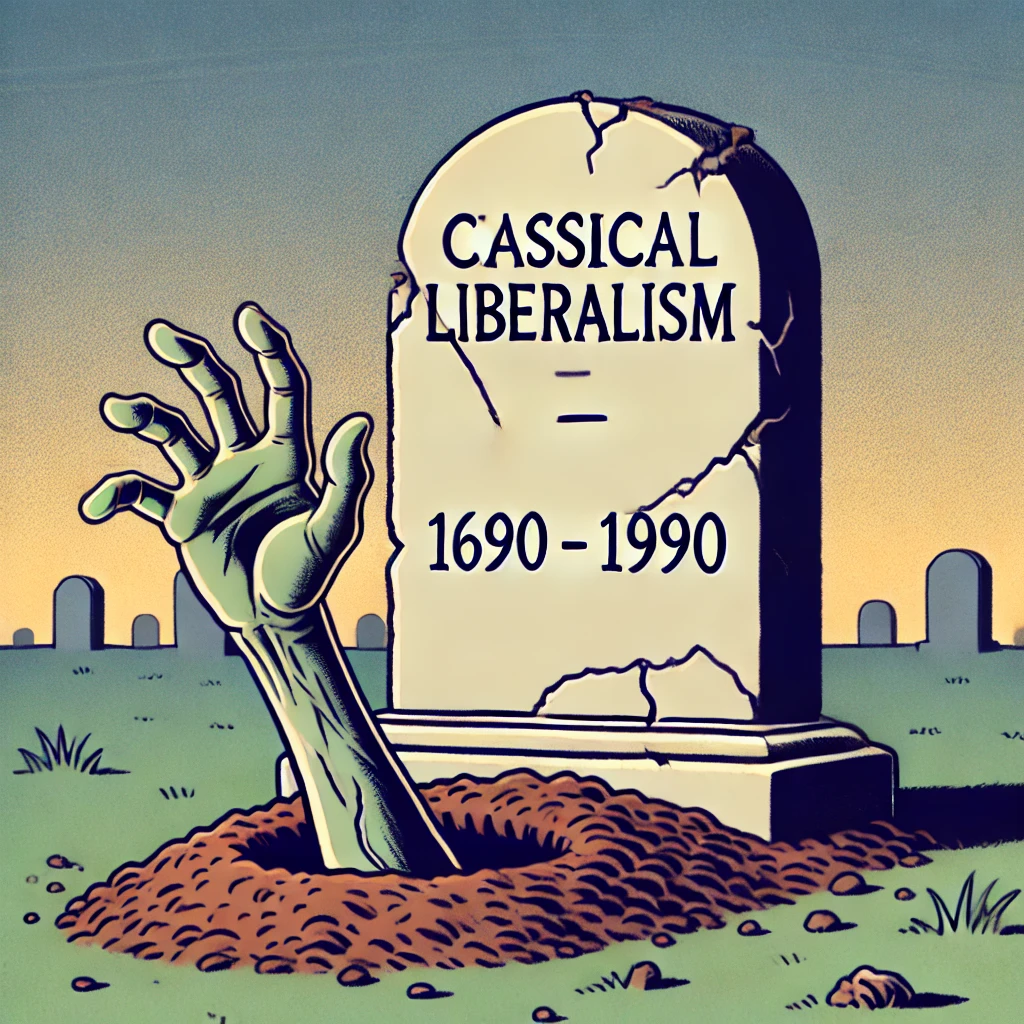Your cart is currently empty!

The Demonization of Classical Liberalism
Two Case Studies in The Modern Era
In the media-driven era we live in today, it has become increasingly easy for powerful institutions to influence public perception, especially regarding political figures who challenge the status quo. Through carefully crafted media narratives, selective framing, and sensationalized headlines, politicians who advocate for classical liberal values are often misrepresented. Classical liberalism, as originally articulated by thinkers like John Locke and Adam Smith, emphasizes individual liberty, free markets, and limited government—principles that have long been central to American political thought. However, modern portrayals often distort these values, equating them with extremism. There are two figures who emphasized nationalism, economic protectionism, and individual liberty in our modern political zeitgeist who have been systematically portrayed as extremists. Despite the media’s portrayal, their views align closely with the traditional values of classical liberalism foundational to the formation of the U.S. Constitution. Their treatment by the media serves as a case study in how classical liberalism is systematically mischaracterized in modern political discourse in favor of corporate-influenced neoliberal policies.
Classical Liberalism at Its Core
At its heart, classical liberalism emphasizes:
- Free markets, with limited government intervention to protect national interests.
- National sovereignty and the primacy of individual rights over collectivist agendas.
- A non-interventionist foreign policy, prioritizing national interests over global policing.
- A belief in individual responsibility and skepticism toward centralized power.
These principles, evident in both Politician 1’s and Politician 2’s platforms, have long been core to American political thought. Classical liberalism differs from modern liberalism in that it prioritizes individual freedom and minimal government over collective social welfare policies. Yet, media outlets often reframed these politicians’ policies to paint them as radical, diverting attention from the nuanced arguments they presented.
Politician 1: A Classical Liberal Misrepresented
Politician 1’s political platform was built on economic nationalism, immigration control, cultural preservation, and non-interventionist foreign policy—all reflective of classical liberal ideals. However, media coverage often portrayed Politician 1 as far more extreme than his policies warranted.
- Economic Nationalism: Politician 1’s stance on free trade agreements, particularly his opposition to NAFTA, was rooted in a desire to protect American workers and industries from the pressures of globalization. He advocated for protective tariffs to safeguard U.S. manufacturing jobs. This position aligns with classical liberalism’s concern for national autonomy and economic independence.
- Immigration Control: Politician 1’s approach to immigration was strict. He advocated for strict limits on both legal and illegal immigration, arguing that mass immigration from non-Western countries could weaken American cultural cohesion and strain economic resources. His advocacy for assimilation into American culture as a means of preserving national unity is a perspective grounded in classical liberalism’s emphasis on societal coherence.
- Social and Cultural Policies: Politician 1’s positions on abortion and family values reflected his deeply conservative outlook. His advocacy for a total ban on abortion was consistent with his broader defense of traditional social structures, but it often overshadowed his classical liberal economic stances in media portrayals.
- Foreign Policy: A vocal critic of U.S. military interventions, Politician 1’s non-interventionist foreign policy reflected a classical liberal skepticism of entanglements abroad. His opposition to globalist agendas aligned with the belief in national sovereignty as a cornerstone of American policy.
Politician 2: A Populist Successor
Politician 2 continued Politician 1’s populist message with a modern twist, adopting many of his positions while tailoring them to a changing political landscape.
- Economic Nationalism: Politician 2, like Politician 1, emphasized protectionist trade policies designed to benefit American workers. His 2016 campaign centered on renegotiating trade deals such as NAFTA and imposing tariffs on foreign goods to revive U.S. manufacturing. However, Politician 2’s approach was more pragmatic, seeking to reform rather than halt trade agreements altogether.
- Immigration: Politician 2’s immigration policies, particularly his call for a border wall, echoed Politician 1’s emphasis on border security. However, unlike Politician 1, Politician 2 did not advocate for a moratorium on legal immigration, instead favoring merit-based reforms. His more moderate approach reflects the evolving complexities of immigration in a globalized world.
- Foreign Policy: Politician 2, like Politician 1, adopted a non-interventionist stance, withdrawing from several international agreements and reducing military involvement abroad. This reflected a shared belief in prioritizing national interests over global obligations.
- Abortion and Social Policies: While Politician 2 personally disagreed with abortion, he took a more moderate stance, believing it was fundamentally a states’ rights issue. He argued that each state should have the authority to decide its own abortion laws, reflecting his broader belief in decentralizing social policy. Additionally, Politician 2 was a strong supporter of in vitro fertilization (IVF), advocating for programs that would help families afford IVF treatments, demonstrating his commitment to policies that support family growth and reproductive health options beyond the abortion debate.
Interestingly, the Supreme Court, shaped by key appointments during Politician 2’s administration, overturned Roe v. Wade. This decision did not ban abortion but returned the decision-making power to individual states, allowing them to determine their own abortion laws. The same Supreme Court also ruled that over-the-counter oral contraceptives, such as the morning-after pill, were constitutionally protected, further reflecting the Court’s position on reproductive rights. Moreover, Politician 2’s influence on the Republican Party led to a significant shift, as his stance on decentralizing the abortion issue contributed to the party eventually removing abortion from its official platform, signaling a departure from a traditionally more rigid stance on the matter. This broader move toward decentralizing social policy was echoed in the overturning of the Chevron Doctrine, which similarly returned regulatory oversight powers to Congress, limiting the authority of federal agencies.
Media Tactics: Demonizing Classical Liberalism
The media’s portrayal of Politician 1 and Politician 2 reveals a pattern of misrepresentation often applied to figures advocating for classical liberalism. Several key propaganda techniques are employed to skew public perception:
- Guilt by Association:
Both figures were accused of harboring extremist sympathies due to their associations with controversial individuals or groups. Politician 1, for example, was criticized for appearing on radio shows associated with white nationalist views, despite never endorsing such views directly. Similarly, Politician 2 faced accusations of aligning with far-right groups, such as the Proud Boys—a group that initially began as a joke, mocking both overly masculine and politically correct culture, but later became radicalized as media sensationalism and constant attacks turned them from irreverent provocation into a more extreme identity. These associations overshadowed a policy platform that focused on economic nationalism and deregulating small business. - Out-of-Context Framing:
Media outlets frequently took isolated comments from Politician 1 and Politician 2 and presented them out of context to paint them as divisive or extreme. Politician 1’s critiques of multiculturalism were framed as xenophobic, ignoring his focus on preserving cultural cohesion, while Politician 2’s comments on immigration were presented as racially motivated. - False Dichotomies:
Both Politician 1 and Politician 2 were placed within a false dichotomy that framed their positions as either far-right extremism or progressivism. Any opposition to globalism or multiculturalism was immediately labeled as xenophobic, obscuring the more nuanced discussions of national sovereignty and economic protectionism.
Favoring Neoliberal Progressivism: A Corporate-Driven Alternative
While the media often distorts classical liberalism as extremist, it simultaneously presents neoliberal progressive policies as the more sensible and pragmatic alternative. However, these policies frequently align with corporate interests, often prioritizing the needs of powerful economic elites over individual liberty and national sovereignty. By framing neoliberal progressivism as the reasonable choice, the media shifts public discourse away from critical engagement with policies that benefit the general population.
One clear example of this is in the area of economic policy. Neoliberal progressivism often promotes free trade agreements like NAFTA and the Trans-Pacific Partnership (TPP) as necessary steps toward globalization and economic growth. However, these agreements have historically benefited multinational corporations at the expense of domestic workers. By outsourcing manufacturing jobs and driving down wages, free trade policies hurt American workers—yet the media often portrays these agreements as crucial for progress, dismissing opposition to them as reactionary or isolationist.
Another example can be found in environmental policy, where large corporations often influence climate change initiatives. Many mainstream environmental solutions—such as carbon credits and cap-and-trade systems—have been designed to benefit corporate entities that can easily absorb the costs while avoiding meaningful changes to their operations. Meanwhile, small businesses and individual citizens often bear the brunt of these policies. Despite these imbalances, the media frequently frames these solutions as the only viable path forward, stifling alternative approaches that might prioritize sustainability without benefiting corporate interests disproportionately.
In terms of social policy, progressive neoliberal agendas frequently promote policies that seem inclusive on the surface but often serve to consolidate power for elites. For example, tech companies and large corporations champion diversity initiatives, but these efforts are frequently used as a shield to avoid scrutiny over unethical practices such as monopolistic behavior, exploitative labor conditions, and tax avoidance. The media’s portrayal of such initiatives as unequivocally positive obscures the deeper issue of corporate-driven inequality, making it difficult to critically assess the true beneficiaries of these policies.
In this way, while classical liberal values are reframed as outdated or extreme, neoliberal progressive policies—which often serve corporate interests—are presented as progressive and forward-thinking. This one-sided portrayal limits public discourse and prevents the exploration of alternatives that prioritize the well-being of citizens over corporations.
A Systematic Effort to Undermine Classical Liberalism
By now, you’ve probably guessed who Politician 1 and Politician 2 are, but the media has done such an effective job of attaching these names to extreme emotions that I chose to present their ideas without fighting the psychological impact associated with the names themselves. Pat Buchanan and Donald Trump, two prominent political figures often linked to nationalism and populism, serve as examples of how classical liberalism has been systematically distorted in modern media.
Both figures were framed as extremists, despite their platforms being rooted in traditional principles of national sovereignty, economic self-determination, and the defense of individual liberties. By employing techniques such as guilt by association, out-of-context framing, and false dichotomies, the media has been able to dismiss these figures without engaging with the substance of their arguments. In doing so, they obscure the real motivations behind classical liberal policies and present a skewed version of reality to the public.
As we move forward, it is essential that we critically engage with media narratives, ensuring that legitimate political discourse is not overshadowed by sensationalism. The demonization of figures like Buchanan and Trump should remind us of the importance of questioning mainstream portrayals and striving for a more nuanced understanding of classical liberalism in modern political discourse.
Further Reading:
- Buchanan, Pat. State of Emergency: The Third World Invasion and Conquest of America.
- Speeches from Pat Buchanan’s 1992 and 1996 presidential campaigns. Republic Not An Empire Speech
- Donald Trump’s foreign and domestic policies. 2024 platform
Resources on Media Manipulation:
- Navigating Media Bias
- How to Spot Propaganda
- Cultural Subversion
- The Propaganda of Labels: Democracy vs. Republic
- What Does “Conspiracy Theory” Mean?
- Are “Dog Whistles” real?
- Is Fascism Really Right-Wing?

Leave a Reply